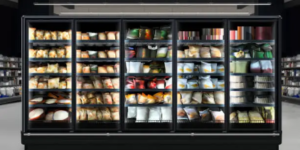The flavour of a fresh strawberry, just-caught fish or vegetable from the produce section is hard to beat. But can frozen food taste as good?
 While freezing disrupts a food’s cellular structure, advancements in food technology can create frozen foods that closely resemble their fresh counterparts. Plus, many healthy frozen meals are made with lower amounts of sodium. For fresh tasting frozen food, check this out.
While freezing disrupts a food’s cellular structure, advancements in food technology can create frozen foods that closely resemble their fresh counterparts. Plus, many healthy frozen meals are made with lower amounts of sodium. For fresh tasting frozen food, check this out.
Flavor
All the flavours are vibrant when something is fresh, like a brightly coloured drawing. But as it ages, the colours gradually fade, and food can become duller. Freezing slows the process of aging, but it’s not foolproof. When food freezes, some juices can get trapped in ice crystals, and the food can lose a bit of its crunchiness and flavour.
The cellular structure of the food can also change during freezing, resulting in a mushy texture and diluted flavour. To minimize these effects, companies use techniques like flash freezing.
The best-frozen foods have a similar texture and flavour to their fresher counterparts. But if you want to be sure, read the ingredients list and look for foods with less sodium. Sodium is a preservative and adds flavour, but too much can overpower a meal. Foods that don’t freeze well include cream-based sauces, coffee and some fruits and veggies with a high water content.
Texture
Many fresh foods retain their flavour and texture better in the freezer than in a refrigerator. It includes meats such as pork chops, chicken breasts, beef tenderloin, frozen vegetables, whole grains, and beans. For fresh tasting frozen food, check this out.
The taste of frozen foods varies, depending on the freezing process and ingredients. Foods with high water content, such as fruits and lettuce, don’t freeze well because the ice crystals rupture cell walls, leaving them soft and mushy after thawing.
But other foods, such as cream-based sauces and coffee, do better in the freezer. While many comfort foods lose their smooth, creamy textures in the freezer (due to dehydration and the formation of ice crystals), today’s technology and ingredient solutions can help these products retain their fresh characteristics. It makes frozen versions of these comfort foods more appealing and accessible.
Nutrition
For many health-conscious people, the freezer aisle is a no-go area. They may believe that frozen food is overprocessed and full of preservatives. However, this perception is changing. With more and more premium frozen meals that contain whole grains, quinoa, and sweet potatoes, it’s possible to find healthy frozen foods.
When shopping for frozen foods, look at the nutritional label. You’ll want to choose those free of added sauces, salt, and sugar. These ingredients can add up quickly regarding sodium content and saturated fat. Also, remember to check the serving size of the frozen dish you’re considering. Larger serving sizes can have more calories than you need.
Preparation
Food snobs might groan, but some frozen foods taste better than fresh. That’s because frozen produce doesn’t spend time on a shelf or in a cooler, where enzymes break down sugars and other compounds that create flavour, texture and nutrition.
Frozen veggies retain colour and texture well, too, according to research. So do firm grains, which often have a more robust, nutty flavour than their fresh counterparts.
The key to making frozen foods taste better is correct preparation. Always read the label to see if a product needs to be cooked or thawed. If it does, plan your meal prep and grocery shopping days to ensure the ingredients are as fresh as possible.
And don’t forget to add extras that will make your freezer meals pop, like herbs and garlic. The allicin in garlic and onions has an antibacterial, immune-boosting effect, explains RD Liz Weinandy.
So go ahead and stock up on your favourite frozen foods. Just be sure to look for the “slow-cooked” label and avoid overly processed foods that are high in sodium. And don’t forget to check the nutrient content of your frozen selections, just as you would with any other grocery item—the more processed the food, the higher its calorie and sodium content. Look for foods with fewer than five ingredients to keep your sodium levels in check.
